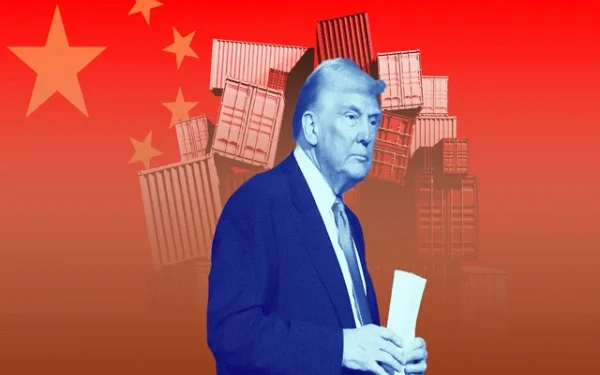Introduction: Major Shift in U.S. Trade Policy
In a significant move that has sent ripples through the global economic and political landscape, U.S. President Donald Trump has announced the suspension of tariffs on countries around the world—except China—for a period of three months. However, during this period, a 10% tariff will still apply to these nations. More notably, the Trump administration has escalated its trade war with Beijing by immediately increasing tariffs on Chinese goods to a staggering 125%.
This dramatic announcement marks one of the most aggressive trade policy moves yet by the Trump administration, signaling a clear message of confrontation toward China while offering a temporary olive branch to other trading partners.
Details of the Tariff Decision
Temporary Relief for the Rest of the World
President Trump’s decision to suspend tariffs for the rest of the world is being seen as a strategic maneuver. While countries across Europe, Asia, and the Americas will enjoy a temporary reprieve from the full weight of American tariffs, they will still be subjected to a 10% tariff for the next three months.
According to White House officials, this decision aims to de-escalate tensions with traditional allies and trading partners while isolating China for what the U.S. government calls “unfair trade practices, intellectual property theft, and economic espionage.”
China Targeted with Steep 125% Tariff
The most striking part of this announcement is the sudden and aggressive increase in tariffs on Chinese goods, which now stand at 125%. This move is intended to pressure Beijing into complying with U.S. demands concerning trade imbalances, technology transfer practices, and alleged breaches of international trade rules.
Speaking at a press conference in Washington D.C., President Trump declared:
“China must understand that deception and economic manipulation will no longer be tolerated. These new tariffs are a direct response to years of unfair trade behavior that has hurt American workers and industries.”
Global Market Reactions: Oil and Stocks Surge
Following the announcement, financial markets around the world reacted with dramatic volatility. Interestingly, the response was largely positive outside China, as investors interpreted the suspension of tariffs on most countries as a sign of temporary trade stability.
Oil Prices Jump Nearly 4%
One of the immediate consequences of Trump’s announcement was a sharp increase in global oil prices. Crude oil benchmarks rose by nearly 4%, driven by expectations that reduced global trade tensions (outside of China) could lead to an increase in industrial activity and fuel demand.
U.S. Stock Market Rallies 7%
Wall Street responded with a powerful rally. The Dow Jones Industrial Average, NASDAQ, and S&P 500 all surged by approximately 7%, reflecting investor optimism that a global trade war could be averted—at least temporarily.
Tech stocks, which had been under pressure due to concerns about international supply chains and tariff hikes, led the gains, with companies like Apple, Microsoft, and Amazon seeing strong recoveries.
European Union Strikes Back with Tariffs of Its Own
In a related development, the European Union has announced 25% retaliatory tariffs on a range of American goods in response to earlier U.S. tariffs imposed on European exports. These new EU tariffs are scheduled to go into effect on April 15, intensifying the already strained transatlantic trade relations.
EU officials emphasized that the move was not a provocation but a defensive measure to protect European industries and workers from what they perceive as unjust U.S. trade actions.
China Responds with Strong Retaliation: 84% Tariffs on U.S. Goods
The Chinese government wasted no time in responding to the U.S. decision. A spokesperson from China’s Ministry of Commerce issued a stern statement, warning that Beijing will not back down.
“If the U.S. insists on pursuing this unilateral and hostile course of action, China will fight to the last breath to defend its interests, its industries, and its sovereignty.”
As part of its immediate retaliation, China has imposed an 84% tariff on a range of U.S. goods, with these measures taking effect immediately. The Chinese tariffs are expected to impact sectors such as agriculture, manufacturing, and electronics—many of which are politically significant to the Trump administration’s voter base.
Analysis: What Does This Mean for the Global Economy?
Trade Wars and Economic Uncertainty
The escalation of tariffs between the United States and China has reignited fears of a full-scale trade war, which could have far-reaching implications for the global economy. Analysts warn that continued tit-for-tat tariffs could slow global trade, disrupt supply chains, and lead to inflationary pressures in various countries.
While the temporary suspension of tariffs for countries outside China may reduce some friction in the short term, the uncertainty remains high, particularly with regard to long-term global trade relations.
Strategic Calculations Behind Trump’s Move
Experts suggest that President Trump’s decision to spare other countries temporarily is likely a calculated move to isolate China and strengthen U.S. alliances, especially in Europe and Asia. By demonstrating flexibility with allies, the U.S. might be seeking to build a united front against Beijing’s economic policies.
However, this strategy carries significant risks. If the trade war with China escalates beyond tariffs—into areas such as currency manipulation, sanctions, or restrictions on technology exchange—it could further destabilize global markets.
Political Implications at Home and Abroad
Domestic Support and Criticism
Within the United States, President Trump’s bold tariff move has drawn mixed reactions. Supporters hail the decision as a necessary step to protect American jobs, industries, and intellectual property. Critics, however, warn that the tariffs could backfire by raising consumer prices and inviting further retaliation.
Diplomatic Repercussions
Globally, the U.S. decision is likely to complicate diplomatic relations, particularly with China. Trade disputes often spill over into other areas, such as military cooperation, environmental policy, and geopolitical alliances.
What’s Next: The Road Ahead for U.S.-China Trade Relations
Trade experts believe that both the U.S. and China will now engage in a high-stakes economic chess game. Negotiations could still be possible behind closed doors, but with national pride and economic stakes involved, neither side is expected to back down easily.
As both countries impose harsh tariffs, industries in both nations—and the world at large—are bracing for potential disruptions in everything from electronics and automobiles to agriculture and energy.
Conclusion: A Tense Global Trade Environment
The suspension of tariffs for much of the world by the United States provides temporary relief for international trade partners, but the dramatic escalation of tariffs against China has raised tensions to new heights. With oil prices rising and stock markets reacting sharply, the world is watching closely to see how this renewed trade conflict between two economic superpowers will unfold.
Only time will tell whether this move will force China back to the negotiating table—or push the world closer to a prolonged and damaging economic confrontation.

























